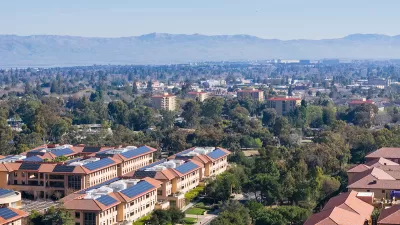The city of Palo Alto, a city central to the geographic and economic might of Silicon Valley, is planning a significant overhaul to its plans for the future, making space for over 6,000 new housing units in the next eight years.

New state laws and newly strict oversight from state regulators have pressured cities all over California into adopting more aggressive plans for housing development in the next eight years. The latest example can be found in Palo Alto, but state regulators will still have to decide if the plans are enough.
“After approving an ambitious plan to make room for more than 6,000 new dwellings by 2031, Palo Alto is preparing to take the scalpel to its zoning code next month with the aim of removing barriers for housing developers,” reports Gennady Sheyner.
The ambitious plan referenced at the beginning of that sentence is the city’s new Housing Element, approved by the City Council in May 2023 to meet the state-mandated Regional Housing Needs Assessment process, which created legal drama up and down the state of California in recent years. Palo Alto’s new Housing Element is still awaiting approval by the California Department of Housing and Community Development.
The city is moving ahead with the zoning changes needed to hit its housing targets anyway, according to the Sheyner. “Some of these zoning revisions, including the loosening of density limits for multi-family developments, will be reviewed by local commissions and the council later this year with the target of adopting them by the end of this year.”
“Other changes will take longer to enact. These include, most notably, the expansion of the city's Housing Incentive Program (HIP), which relaxes zoning standards for affordable housing developments,” adds Sheyner.
The most significant changes to Palo Alto’s zoning, however, will attend to the commercial, industrial and mixed-use areas in southeast Palo Alto, where the city hopes to locate 2,000 new housing units in the next eight years.
“Sites along San Antonio Road, West Bayshore Road and East Charleston Road that are currently zoned for ‘general manufacturing’ (GM) and ‘research, office and limited manufacturing’ (ROLM) will get the heaviest dose of densification, with new projects allowed to build up to 90 dwellings per acre. Today's zoning code, by contrast, allows a maximum of 40 dwellings per acre in the city's densest residential districts,” explains Sheyner.
More details on the city’s new zoning code are included at the source article, linked below. A committee review and a full council vote will be required to approve the zoning changes. The current plan is to adopt the new zoning code by November.
FULL STORY: To encourage housing construction, Palo Alto looks to revise its zoning code

Alabama: Trump Terminates Settlements for Black Communities Harmed By Raw Sewage
Trump deemed the landmark civil rights agreement “illegal DEI and environmental justice policy.”

Planetizen Federal Action Tracker
A weekly monitor of how Trump’s orders and actions are impacting planners and planning in America.

The 120 Year Old Tiny Home Villages That Sheltered San Francisco’s Earthquake Refugees
More than a century ago, San Francisco mobilized to house thousands of residents displaced by the 1906 earthquake. Could their strategy offer a model for the present?

Ken Jennings Launches Transit Web Series
The Jeopardy champ wants you to ride public transit.

BLM To Rescind Public Lands Rule
The change will downgrade conservation, once again putting federal land at risk for mining and other extractive uses.

Indy Neighborhood Group Builds Temporary Multi-Use Path
Community members, aided in part by funding from the city, repurposed a vehicle lane to create a protected bike and pedestrian path for the summer season.
Urban Design for Planners 1: Software Tools
This six-course series explores essential urban design concepts using open source software and equips planners with the tools they need to participate fully in the urban design process.
Planning for Universal Design
Learn the tools for implementing Universal Design in planning regulations.
Clanton & Associates, Inc.
Jessamine County Fiscal Court
Institute for Housing and Urban Development Studies (IHS)
City of Grandview
Harvard GSD Executive Education
Toledo-Lucas County Plan Commissions
Salt Lake City
NYU Wagner Graduate School of Public Service





























